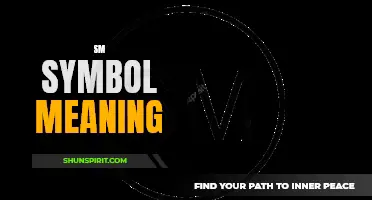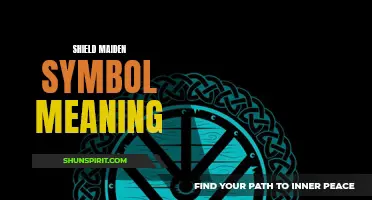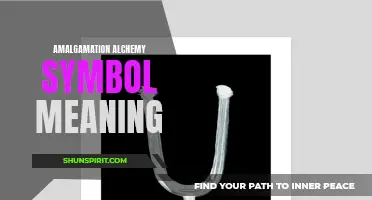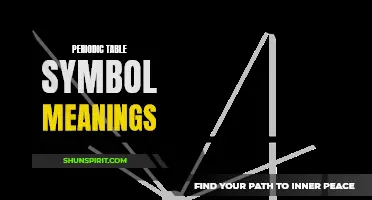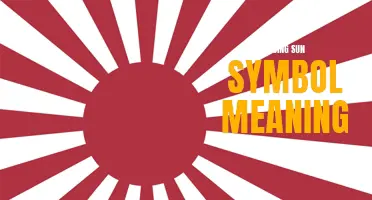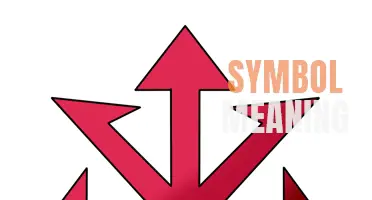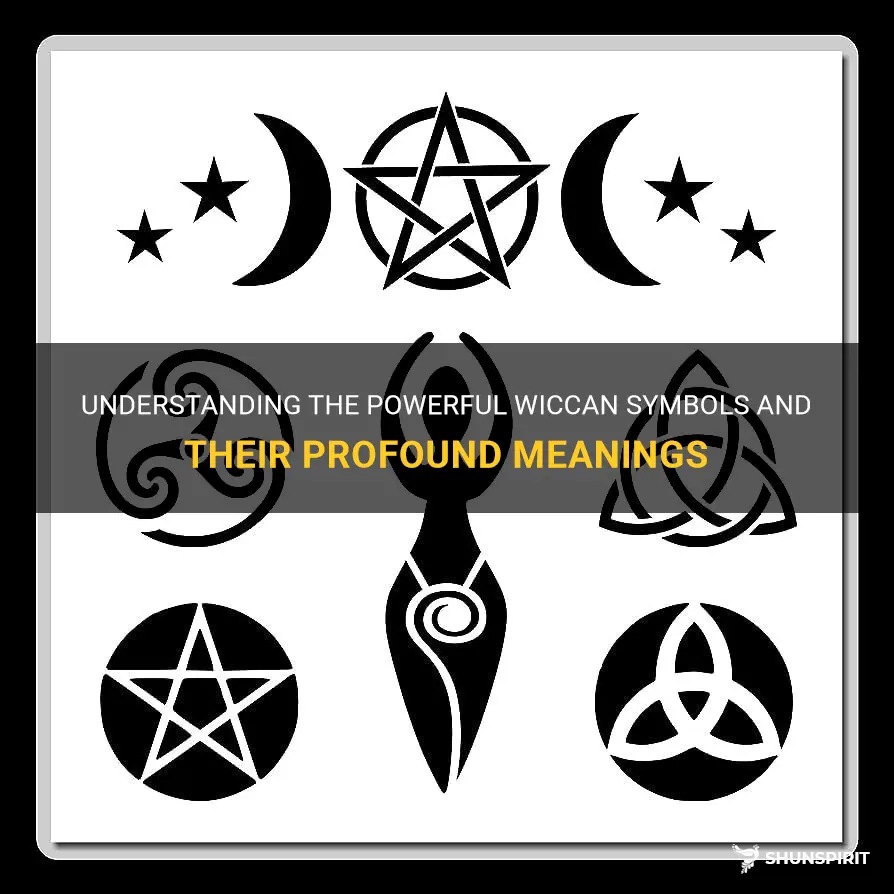
Wiccan symbols have long been a source of intrigue and fascination, offering a glimpse into the mystical world of Wicca. With their various shapes and intricate designs, these symbols hold deep significance and meaning for practitioners of this nature-based religion. From the Triple Goddess symbol to the Pentacle, each symbol tells a unique story and represents a different aspect of spiritual and magical beliefs. Whether you are curious about their origins, their hidden meanings, or simply drawn to their beauty, exploring Wiccan symbols is a captivating journey into the mystical realm of this ancient practice.
What You'll Learn
- What are the most common Wiccan symbols and their meanings?
- How do Wiccan symbols connect practitioners to their beliefs and spirituality?
- Can you explain the history and origins of some important Wiccan symbols?
- Are there any lesser-known Wiccan symbols that hold significant meaning in the practice?
- Are Wiccan symbols universal, or do their meanings vary among different Wiccan traditions or individuals?

What are the most common Wiccan symbols and their meanings?
Wicca is a modern pagan religion that draws its roots from pre-Christian traditions, particularly in Europe. It is a nature-based religion that celebrates the cycles of the seasons and takes inspiration from various cultures and mythologies. Wiccans use symbols to represent their beliefs and practices, and these symbols often have deep meanings associated with them.
Here are some of the most common Wiccan symbols and their meanings:
- Pentacle: The pentacle is one of the most widely recognized Wiccan symbols. It is a five-pointed star within a circle. The five points represent the four elements - earth, air, fire, and water - with the fifth point representing the spirit. The circle represents unity and protection. The pentacle is a symbol of the interconnectedness of all things and is often worn as jewelry or used in rituals for protection and grounding.
- Triple Moon: The triple moon symbol consists of three interlocking crescent moons, with the points facing upward and outward. Each crescent moon represents a different phase of the moon - waxing, full, and waning. The waxing moon represents growth and new beginnings, the full moon represents abundance and manifestation, and the waning moon represents release and letting go. The triple moon symbol is often associated with the triple goddess, representing the maiden, mother, and crone aspects of the divine feminine.
- Triquetra: The triquetra is a three-pointed knot interwoven with a circle. It is a symbol of the triple aspect of the divine - the maiden, mother, and crone - as well as the cycles of life, death, and rebirth. The triquetra can also represent the different aspects of the self - mind, body, and spirit - and the interconnectedness of these aspects.
- Wheel of the Year: The wheel of the year is a representation of the eight Sabbats or festivals celebrated by Wiccans throughout the year. The wheel is divided into eight sections, each corresponding to a specific holiday such as Samhain, Yule, Imbolc, Ostara, Beltane, Litha, Lammas, and Mabon. The wheel of the year symbolizes the cyclical nature of the seasons and the importance of honoring the natural rhythms of life.
- Ankh: The ankh is an ancient Egyptian symbol that represents life and immortality. It is a looped cross with a handle and is often associated with the goddess Isis. The ankh is used in Wiccan rituals as a symbol of life force energy and spiritual connection.
These are just a few of the many symbols used in Wiccan practices. Each symbol carries its own unique meaning and significance, and their use can vary among different Wiccan traditions and practitioners. The symbols serve as visual representations of the beliefs and principles of Wicca and are often used in rituals, ceremonies, jewelry, and artwork to connect with the divine and symbolize the magic and power of the natural world.
Understanding the Symbolic Meaning of the Coqui Taino Symbol
You may want to see also

How do Wiccan symbols connect practitioners to their beliefs and spirituality?
Wicca is a modern pagan religious movement that places emphasis on nature worship and the celebration of the cycles of the seasons. It is a spiritual path that connects practitioners to their beliefs through rituals, ceremonies, and symbols. Wiccan symbols serve as powerful tools for connecting with the divine, manifesting intentions, and deepening spiritual experiences.
Symbols in Wicca are often associated with specific deities, elements, or concepts. They are used to represent these energies and create a connection between the practitioner and the spiritual realm. Moreover, symbols serve as a language of the subconscious mind, communicating and reinforcing beliefs and intentions in a non-verbal way.
One of the most well-known Wiccan symbols is the pentacle, which is a five-pointed star enclosed within a circle. This symbol represents the five elements of nature - earth, air, fire, water, and spirit - and the circle represents the eternal cycles of life, death, and rebirth. Witches often wear or display the pentacle to symbolize their connection to the natural world and their dedication to honoring the divine forces within it.
The triple moon symbol is another significant Wiccan symbol. It consists of three interlocking crescent moons, with each moon representing a different phase of the lunar cycle - waxing, full, and waning. The triple moon symbol is associated with the goddess in her three aspects: maiden, mother, and crone. It symbolizes the cycles of life, fertility, and transformation, and is commonly used in rituals related to the feminine divine and lunar magic.
The Wiccan wheel of the year is a circular symbol that represents the eight Sabbats, or seasonal festivals, celebrated in Wicca. These festivals mark the changing seasons and the cycles of life, and they include important dates such as Samhain, Yule, Imbolc, Ostara, Beltane, Litha, Lammas, and Mabon. The wheel of the year serves as a reminder of the cyclical nature of existence and helps practitioners attune themselves to the natural rhythms of the Earth.
In addition to these specific symbols, Wiccan practitioners often use various tools and implements in their rituals. These may include athames (ritual knives), wands, chalices, cauldrons, and brooms, each with its own symbolic meaning and purpose. These tools act as extensions of the practitioner's own energy and intention, helping to focus and direct their spiritual practice.
By incorporating symbols and tools into their rituals, Wiccans create a bridge between the seen and unseen worlds. They tap into the power and wisdom of the earth, the elements, and the divine forces that govern the universe. These symbols serve as reminders of the interconnectedness of all things and help practitioners to align themselves with their beliefs, deepen their spirituality, and manifest their desires.
Ultimately, Wiccan symbols function as gateways to the divine, allowing practitioners to tap into the vast cosmic energies that surround them. They provide a visual and tangible representation of abstract concepts, making them more accessible and relatable. Through the use of symbols, Wiccans connect with their beliefs, strengthen their connection to the spiritual realm, and experience a greater sense of unity with the natural world.
Understanding the Meaning of the Lock Symbol on Text Messages
You may want to see also

Can you explain the history and origins of some important Wiccan symbols?
Wicca is a modern pagan religious movement that emerged in the 20th century. It draws inspiration from various ancient pagan practices, folklore, and traditions. Like many religions, symbolism plays an important role in Wicca. Wiccans use symbols to represent their beliefs, rituals, and connection to nature.
One of the most well-known symbols in Wicca is the pentacle. The pentacle symbolizes the five elements: earth, air, fire, water, and spirit. It consists of a five-pointed star enclosed in a circle. Each point of the star corresponds to one of the elements and represents a different aspect of life. The pentacle is often used in rituals and ceremonies to invoke protection and balance.
Another important symbol in Wicca is the triple moon symbol. It represents the phases of the moon and the three aspects of the goddess: the maiden, the mother, and the crone. The waxing crescent moon represents the maiden, symbolizing new beginnings and growth. The full moon represents the mother, symbolizing fertility and abundance. The waning crescent moon represents the crone, symbolizing wisdom and transformation. The triple moon symbol is often used in rituals and meditation to honor the cycles of nature and the goddess.
The triquetra is another symbol commonly used in Wicca. It is a threefold knot with interlocking circles and represents the trinity of the goddess and god. The three points of the triquetra symbolize the three aspects of the goddess (maiden, mother, and crone) and the three stages of life (birth, life, and death). The triquetra is often used in spells, charms, and jewelry to invoke the power of the goddess and god.
The pentagram is another symbol used in Wicca. It is a five-pointed star with a single point facing upwards. The pentagram has been associated with various meanings throughout history and different cultures. In Wicca, the pentagram represents the elements and the connection between the physical and spiritual realms. It is often used as a protection symbol and is worn as jewelry or used in rituals.
Lastly, the cauldron is a symbol often associated with Wicca. It represents transformation, brewing, and the power of the elements. The cauldron is used in rituals and spells to mix ingredients, burn incense, and create sacred potions. It is considered a sacred tool in Wiccan practice and symbolizes the womb of the goddess.
These symbols are just a few examples of the rich symbolism found within Wicca. Each symbol carries its own unique meaning and represents different aspects of the Wiccan faith. They are used to deepen spiritual connection, invoke energy, and celebrate the cycles of nature. By understanding and embracing these symbols, Wiccans can further explore their beliefs and connect with the divine forces that surround them.
Decoding the Mystery: Understanding the Symbols on Your Fridge
You may want to see also

Are there any lesser-known Wiccan symbols that hold significant meaning in the practice?
Wicca is a religious practice that combines witchcraft and nature-based spirituality. It is a modern Pagan witchcraft tradition that honors the Earth and its natural cycles. Wiccans believe in the existence of a divine universal energy, which they refer to as the Goddess and the God, and they seek to align themselves with this energy for the purpose of personal growth and spiritual connection.
In Wicca, symbols are an important part of the practice. They are used to represent concepts, energies, and deities, and they are often incorporated into rituals, spells, and magical tools. While some Wiccan symbols are well-known and widely recognized, such as the pentagram and the triple moon symbol, there are also lesser-known symbols that hold significant meaning in the practice.
One lesser-known symbol in Wicca is the Wheel of the Year. This symbol represents the cycle of the seasons and the changing of the natural world. It is a circular diagram that is divided into eight sections, each representing a different Sabbat or festival. These festivals mark important points in the agricultural calendar and celebrate the cycles of life, death, and rebirth. The Wheel of the Year is often used in rituals and ceremonies to honor and connect with the Earth's natural cycles.
Another lesser-known symbol in Wicca is the spiral. The spiral is a powerful symbol of growth, evolution, and transformation. It represents the cyclical nature of life, and the journey of the soul as it moves through various stages of spiritual development. The spiral is often used in meditation and visualization exercises to help Wiccans connect with their inner selves and tap into their own personal power.
The triquetra is another lesser-known symbol in Wicca. It is a three-pointed, interlocking knot that is often associated with the Celtic tradition. In Wicca, the triquetra represents the threefold nature of the Goddess, as maiden, mother, and crone. It is a symbol of feminine power and the interconnectedness of all things. The triquetra is often used in rituals and spells to invite the energy of the Goddess into a sacred space.
The cauldron is yet another lesser-known symbol in Wicca. It is a traditional tool used in magical practices, particularly for brewing potions and casting spells. The cauldron symbolizes transformation and the alchemical process of turning base materials into something more refined and powerful. It is often used in rituals to represent the womb of the Goddess and to hold the sacred fire of transformation.
These are just a few examples of lesser-known symbols in Wicca that hold significant meaning in the practice. Each symbol has its own unique energy and symbolism, and Wiccans may choose to incorporate them into their practice in different ways. Whether well-known or lesser-known, symbols are powerful tools that can help Wiccans connect with their spirituality and deepen their understanding of the natural world. They serve as reminders of the sacredness of all things and the interconnectedness of life.
Exploring the Sacred Art: Indonesian Tattoo Symbols and Their Profound Meanings
You may want to see also

Are Wiccan symbols universal, or do their meanings vary among different Wiccan traditions or individuals?
Wiccan symbols hold deep spiritual and magical meanings for those who practice the Wiccan religion. Each symbol is believed to represent a specific concept, element, deity, or energy. However, the meaning and interpretation of Wiccan symbols can vary among different Wiccan traditions and even among individual practitioners.
One of the most well-known symbols in Wicca is the pentacle, a five-pointed star enclosed in a circle. The pentacle is often associated with the five elements (earth, air, fire, water, and spirit) and is considered a symbol of protection and balance. However, the interpretation of the pentacle may vary depending on the tradition or individual. Some Wiccans may also view it as a symbol of the Goddess or the divine feminine.
Another widely used symbol in Wicca is the triple moon symbol, also known as the triple goddess symbol. It consists of three phases of the moon: waxing, full, and waning. The triple moon symbol represents the stages of a woman's life (maiden, mother, and crone) and the cycles of nature. However, some Wiccan traditions may assign different meanings to each phase of the moon or view the triple goddess as representative of different aspects of the divine.
Other symbols commonly used in Wicca include the pentagram (a five-pointed star without the circle), the cauldron, the athame (ritual knife), and various herbs, crystals, and animals. Each symbol carries its own significance and can be used for different magical purposes.
While some symbols may have general meanings across Wiccan traditions, others may have more specific interpretations within certain covens or individual practices. For example, a particular coven may assign a unique meaning to a specific symbol based on their specific beliefs, experiences, or deity preferences.
Furthermore, individual Wiccans may also personalize the meanings of symbols based on their own spiritual journey, experiences, or associations. For example, a Wiccan practitioner who has a strong connection to a particular animal may interpret that animal as a symbol of protection or guidance, even if it is not traditionally associated with that meaning.
It is essential to understand that Wicca is a highly individualistic religion, and practitioners have the freedom to interpret symbols in ways that resonate with them personally. While there are some common symbols and their generally accepted meanings, it is always advisable to consult with fellow practitioners or references within a specific tradition to understand the intended symbolism behind a particular symbol.
In conclusion, Wiccan symbols do hold universal meanings, but their interpretation and significance can vary among different Wiccan traditions or even individual practitioners. The meanings assigned to symbols may be influenced by specific traditions, personal experiences, or personal associations with deities, animals, or elements. It is crucial to respect the diverse interpretations of Wiccan symbols and seek guidance from reliable sources or fellow practitioners to gain a comprehensive understanding of their meanings within a specific tradition.
The Symbolic Meaning of Cranes: A Spiritual Guide to Grace and Longevity
You may want to see also
Frequently asked questions
The pentacle is a central symbol in Wicca and represents the five elements (earth, air, fire, water, and spirit) as well as the five senses and the five points of the human body (head, arms, and legs). It is often used as a protective symbol and is seen as a representation of balance and harmony in nature.
The triple goddess symbol represents the three stages of a woman's life: maiden, mother, and crone. It is a symbol of the cyclical nature of life and the passage of time. The maiden represents youth and innocence, the mother represents fertility and nurturing, and the crone represents wisdom and experience. This symbol is often associated with feminine power and the goddess archetype in Wiccan practice.
The triquetra is a symbol with three interconnected, curved lines that form a knot in the center. It is a symbol of the interconnectedness of the three realms: earth, sea, and sky. In Wicca, it is often associated with the Triple Goddess and represents the three aspects of the feminine divine: maiden, mother, and crone. It is also seen as a symbol of protection and is often used in spells and rituals for warding off negative energies.
The crescent moon is a powerful symbol in Wicca and represents the feminine divine, intuition, and psychic abilities. It is associated with the goddess and the phases of the moon, representing the waxing, full, and waning stages of the lunar cycle. The crescent moon is often used in rituals and spells for manifestation, fertility, and spiritual connection. It is seen as a symbol of transformation and the ever-changing nature of life.


